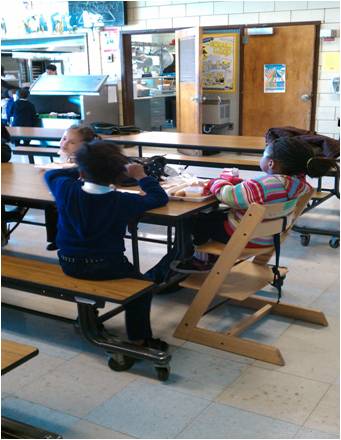Resources
- • Guidelines to Promote Play Opportunities for Children with Disabilities
- • Special needs toy guide provides support for family play, with recommendations from the Let's Play! Project
Environmental Adaptations

Environmental adaptations modify the room arrangement and furniture in a particular location (e.g., classroom, lunch corner, bathroom, kitchen, cubbies or play room) to promote a child’s learning and engagement with peers. A child’s experience of the sensory environment in a particular space/location can also be adapted, and includes lighting, acoustics, temperature, visual, touch-pressure, olfactory and opportunity for type and frequency of movement. Miller Kuhanek et al, 2010
Universal design principles for all children
The preschool story hour in a community library is held in an open, uncrowded room on the first floor so all children (including those who use a wheelchair or other special equipment) can easily enter this space.
In the nearby Little Learners Child Care Center, the layout of the classroom was designed to focus children’s engagement in center activities. A large empty space was eliminated in the center of the room to decrease random running around by the children. In its place, discrete centers (books, art, dress-up, blocks, puzzles) were set up with boundaries created by low shelves and tables to define specific play spaces.
Adaptations for a specific child: Positioning for inclusion
A child sits in a specialized chair to eat lunch in a preschool class in Prince George’s County Public School. This chair supports her in a sitting position at the same height as the other children. The adaptation also enables her to see a story book as the teacher reads it as well as manipulate learning materials at the same table as her peers.
Developmentally appropriate practice & universal design principles for all children
The three year olds in a local Head Start program often like to dress up and pretend to be various workers, animals or characters. Mrs. Hassan, a child care assistant, uses visual supports to encourage the children to engage in creative play by making a sign for the door signaling "The doctor is in!" She also collects dolls and stuffed animals to serve as willing patients. Mrs. Hassan keeps the dress-up supplies e.g., clothes, hats and accessories, in clear plastic bins and “labels” the contents with pictures of what is inside.
Adaptations for Josina to participate in the drama center
Mrs. Hassan meets with her lead teacher and an occupational therapist from the local school system to consider how to make it easier for Josina to put on dress up clothes in the drama center. Josina has Down syndrome and is working on fine motor goals. Mrs. Hassan uses low tech adaptations for the dress-up clothing and accessories by adding a Velcro closure to a boa cape, finds stretchy hats that expand and selects props that are easy to pick up and carry e.g., a doctors bag with a firm, stand up handle and a plastic stethoscope that fits around Josina’s neck easily.
Visual adaptations for Austin to participate in block play
In consultation with Austin’s preschool teacher, his occupational therapist creates a picture template to guide building a block structure. The OTR first tries it out with Austin in the block center to see if the visual aid will work to help Austin build a garage for his car during independent play at other times.
Project CONNECT, Frank Porter Graham Child Development Center

